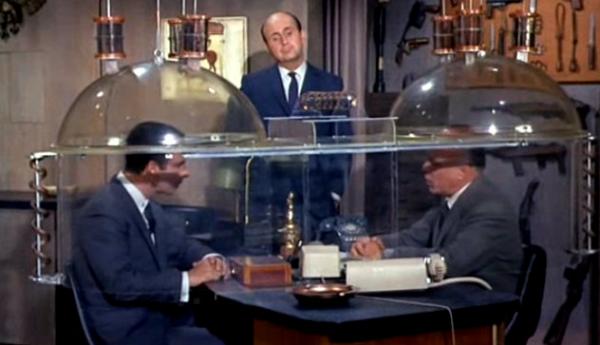The Cone of Silence, Eavesdropping Speakers, Raspberry Pi, and You

The Cone, much like Agent Smart's Shoe Phone, was a running gag on the show. The Cone was supposed to make conversations private, but instead made it impossible for the two spies to hear what the other was saying. In one memorable scene, even though they are shouting, neither can understand the other, while a bystander outside the Cone can hear them both perfectly. I loved the Cone.
Today, we need the Cone of Silence more than ever. There are hundreds of millions of smart speakers out there. Sometimes their little ears hear things that little ears shouldn't hear. We love smart speakers, but we also fear them.
To the rescue comes Project Alias, a modern-day Cone. Yesterday, our crack S&V staff reported on this very nifty piece of technology. Briefly, it is a device that sits atop a smart speaker. It emits an "infecting" noise/sound that masks voices in the room, thus preventing the smart speaker from overhearing them. Then, when you want to use the smart speaker, you say a custom wake word that silences the Alias' masking speakers, and Alias plays a recording of your original wake word to activate the smart speaker, so it can be used normally. In other words, the Alias is a privacy middle-man between you and the smart speaker.
The secret sauce inside the Alias is an offline voice recognition algorithm using open-source machine learning software called TensorFlow. (Ironically, TensorFlow is made by Google, which has a vested interest in smart speakers.) The voice recognition program runs on a neural network that can be trained and modified with your voice. All this is housed in a 3D-printed case.
Now here's the thing: Project Alias is not a product; it is not for sale. Rather, it is a proof of concept that, I hope, will find financial backing. But don't despair. You can build an Alias yourself. Your first thought might be, "Whoa! I could never build something like that!" Well, actually, I bet you could. If you ever soldered together a Heathkit back in the day (perhaps while watching Get Smart) and aren't afraid to flash an SD card and work with a little code, you could build your own Alias. Its developers, Bjorn Karmann and Tore Knudsen, show you exactly how to do it. Bravo to them! This web page gives you the rundown, with all-important links to the building instructions and source code.
First, although a 3D printer would be nice, clearly you can fashion your own (lower-tech) case for the device. The really important stuff is inside. The Alias contains a Raspberry Pi computer, a microphone expansion card, and two tiny speakers. In particular, the Raspberry Pi 3 Model A+ is a single-board computer, measuring a scant 65 x 56 mm. It's small but it packs a punch: 64-bit quad core processor, 512 MB SDRAM, dual-band wireless LAN, Bluetooth, MPEG-4 decoder, audio/video output, and much more. And how much would you pay for such a powerful computer? How about 25 bucks? Yep. Now you see why Raspberry gear is a big deal with students and DIYers everywhere.
With that board in place, along with a ReSpeaker 2-Mics Pi HAT dual-microphone expansion board to the Raspberry, it's fairly easy to attach the speakers (being careful to position them over the smart speaker's own microphones) and connect 5-volt power. Next, flash the software (for either Google or Amazon smart speakers) from your computer to a micro SD card, and put it in the Raspberry. Next, use an app on your phone to train and calibrate the Alias. Lastly, bask in the newfound privacy of your home, free to make use of your smart speaker, confident that it is not ratting you out.
Incidentally, while you are on this Alias overview page, take a second to listen to an audio file of the "infecting" noise/sound that is normally played into the smart speaker. If that doesn't drive a smart speaker crazy, I don't know what will.
I should also mention that as my colleague Leslie Shapiro pointed out, many parents are looking for ways to get their kids into STEM studies. A Raspberry project like this might be perfect.
So is Project Alias a little wacky, or is it fiendishly clever? It is probably both, but I think it is particularly the latter. The world could use a new and improved Cone of Silence that keeps our conversations safe from snooping smart speakers. To those little eavesdroppers, I would echo Maxwell Smart's catch phrase, "Sorry about that, Chief."





























































